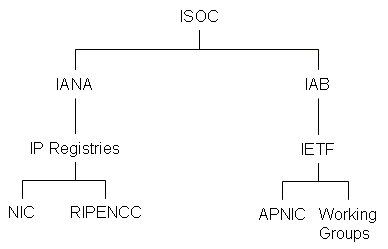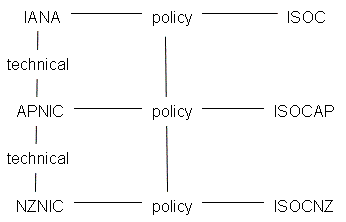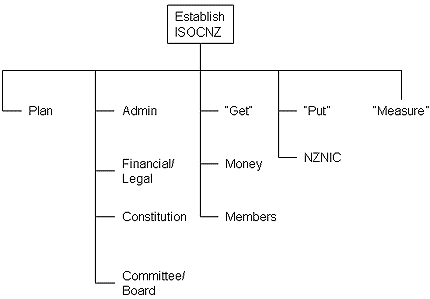History of InternetNZ
Internet NZ History:
Held at Victoria University of Wellington
Present:
Neil James, Otago University (Convener)
Kim Scheinberg, Internet Company of NZ Ltd
Lydia Klimovitch, NZLIA
Peter Whimp, Industrial Research Ltd
Colin Jackson, IT Policy Unit
Frank March, Victoria University if Wellington
Richard Naylor, Wellington City Council
Anne Scott, Lincoln University
John Vorstermans, Actrix Networks Ltd
Ian Mitchell, New Zealand Computer Society&
John Houlker, University of Waikato
Don Hollander, TUANZ
Don Stokes, Victoria University of Wellington
Apologies:
Phillip Lindsay, AgResearch Ltd
Mark Topping, University of Waikato
Jim Higgins, World Communications Laboratory
The meeting opened at 10:10.
Back to topPurpose of Meeting
NJ outlined the history so far. At present, the Tuia Society is the only group purporting to co-ordinate activities on the NZ Internet. At the Tuia AGM late last year, it was accepted that Tuia is not representative of NZ Internet users, and that it should concentrate on its core sites and another organisation should be formed to properly represent the interests of other users. Furthermore, Tuia is prepared to sponsor the formation of this organisation up to $10,000.
The purpose of the meeting is to decide if an NZ Internet Society (ISOCNZ) is needed, and if so, to formulate a plan to form it.
The Internet Society
JH explained the current Internet Society (ISOC) structure:

JH went on to explain the situation as it stands with the domain name system delegations and Internet number assignment. NZ is currently served by the Asia/Pacific Network Information Centre (APNIC) for assignment of Internet numbers. The APNIC is dependent on donations for its funding, a situation that cannot continue indefinitely. Funding relationships with ISOC are preferred over direct charges to users. Name delegation is done by UoW with some delegation to VUW, and some preparatory work toward setting up an NZ NIC is being done.
JH suggested that the relationships should be something like:

Placing an NZNIC directly under the NIC would require top level support. JH also observed that attempts to charge for NIC activities has provoked hails of protest from the Internet community. He also noted that much of the resources consumed in running a NIC are in providing advice to users rather than actual assignments, and that delegating the consulting to providers would greatly reduce the load on an NZNIC.
APNIC expects NZ to provide funding in the vicinity of US$10-20,000.
FM expressed support for the development function of the APNIC, as South East Asia is an increasingly important region for NZ.
JH stated that NZGate is not-for-profit and explained the history.
NZGate started with funding from NASA through the PACCOM consortium which funded half of the initial link and sponsors access through the NSFnet.
Transit through NSFnet access will cease on 30 April 1995.
FM said that Tuia is the only major non-commercial group providing Internet service, and that it had backed away from increasing its membership. As such, it is not representative of the fastest growing sectors, and that some other group needs to take over the network-wide functions. There has been strong resistance from the CRIs toward providing funding for Tuia, leaving it with a budget of $12-15,000, mostly used for covering air fares. A surplus is available for funding the setup of ISOCNZ.
KS raised the question of whether an ISOCNZ should get involved with issues of legal liability, such as the import of the alt.sex newsgroups etc. JH stated that ISOC has avoided getting involved in such issues, so ISOCNZ would be departing from established practice. Rather, ISOC concerns itself with technical matters.
Back to topReasons for establishment of ISOCNZ
NJ brought the discussion back to the question of whether ISOCNZ is necessary, noting that there seemed to be consensus that it is.
Back to topDiscussion of the form ISOCNZ would take
DH saw three areas ISOCNZ could work in: education, administration and service.
JH asked if ISOCNZ should be involved in being a service provider. RN felt that management and funding should be provided for the "logical" level that cannot easily be managed by individual providers. JH agreed that low level service provision should be kept separate. NJ said ISOCNZ has a role in preventing capture of central service.
JH stated that ISOC delegates responsibility but not control of the Internet; control being up to individual countries' legal processes.
FM described the Net Society. The Net Society is an end users group, set up to incorporate users of all networks, not just the Internet, hence the name, but note that the name Internet Society of NZ was very nearly chosen for that group. The group is influenced by the Electronic Frontier Foundation and other similar groups. CJ noted that the Net Society was largely formed in response to Trever Rogers' Technology and Crimes Reform bill, and was more concerned with content of the net than infrastructure. FM pointed out that the only group concerned with infrastructure is Tuia.
NJ asked that the group enunciate the possible objectives of ISOCNZ. RN suggested that NJ's paper be used as a guide.
There was some discussion about funding and structure. JH suggested ISOCNZ should become a legal entity and support an NZNIC, noting that setting up both organisations as separate legal entities would incur significant costs. JH also suggested ISOCNZ should be funded by membership fees.
RN drew a functional diagram of the WCC as a guide:

JH compared ISOC with the ITU, noting that ITU's governance is based on treaties between governments.
NJ quoted the purpose from the ISOCNZ paper, and added that ISOCNZ would not have a role in running the NZ backbone. DH suggested that the word "communicate" should be inserted into the line containing 'co-operate and innovate'. CJ said that ISOCNZ should set an environment for providing services.
- The Purpose
The purpose of NZISOC will be: To maintain and extend the availability of the Internet in New Zealand and its associated technologies and applications, both as an end in itself, and as means of enabling organisations, professionals and individuals to more effectively collaborate, cooperate, communicate and innovate in their respective fields of interest. Following the goals and purpose for ISOC the specific goals and purpose for NZISOC could be:
NJ lead the discussion through the stated goals and purposes.
Under (a), FM suggested that there may be NZ standards worth promoting within NZ:
- a) development, maintenance, evolution, and dissemination of standards for the Internet and its inter-networking technologies and applications;
Under (b), IM noted that "administrative" includes the activities of an NZNIC. NJ said that ISOCNZ should claim control of NZ namespace for administration by NZNIC. JH suggested that ISOCNZ could act as an arbitrator in disputes involving NZNIC activities before such disputes went to court. LK suggested that ISOCNZ should not limit itself too
much in its scope.
- (b) maintenance and evolution of effective administrative processes necessary for operation of the New Zealand Internet;
- (c) passed without further discussion. NJ suggested that (d) should add"including but not limited to IP and DNS":
- (c) education and research related to the Internet and inter-networking;
- (d) harmonization of actions and activities at national levels to facilitate the development and availability of the Internet including but not limited to IP and DNS;
(e) and (f) also pass without further discussion. RN noted that there was not mention of ISOCNZ's position internationally. FM asked if ISOCNZ should select representatives to international forums.
- (e) collection and dissemination of information related to the Internet and inter-networking, including histories and archives;
- (f) liaison with other organizations, New Zealand Government authorities, and the general public for coordination, collaboration, and education in effecting the above purposes.
IM said there should be an expression of the relationship with ISOC. RN suggested adding:
- (g) to co-operate with the international Internet community and to seek a formal relationship with ISOC.
FM and IM added:
- (h) to represent the common interests of wider NZ Internet community.
CJ suggested that there should be a clause stating that common resources
must be uncapturable.
NJ asked what form the entity should take. RN compared DECUS, where DECUS NZ is not a legal entity but is a chapter of the US-based organisation.
IM asked how long it would take to get ISOCNZ underway. NJ asked if ISOCNZ should be an incorporated society. FM asked it ISOCNZ was intending to be not for profit. LK pointed out that incorporated societies can have considerable income and resources.
The meeting broke for lunch at 12:30 and re-convened at 13:15.
Discussion of procedures for the establishment of ISOCNZ
NJ noted that the consensus appeared to be that ISOCNZ would start as an un-incorporated society, and aim to become an incorporated society as soon as possible.
DS observed that the NZNIC portion must get underway very soon as there are pressing issues that need to be resolved. JH pointed out that one case involving domain naming is already before the courts.
NJ asked what members would get. FM stated that ISOCNZ must decide for itself how it will levy fees. This meeting must decide how it is to proceed with setting up ISOCNZ.
RN drew another diagram:

FM suggested setting the Steering Group up as an interim executive, and move in three steps:
- Set up ISOCNZ and announce its presence
- Set up interim arrangements to develop a constitution
- Call for membership and officers
Membership of ISOCNZ steering group
NJ agreed that the Steering Group is the right group to continue the process. RN pointed out that the constitution developed by the Steering Group can only be a draft before being ratified by members. FM suggested a need to set up an open mailing list and newsgroup for ISOCNZ. CJ stated that an internal executive list is also needed.
Election of interim convener of ISOCNZ steering group
NJ called for nominations for a convener. IM nominated NJ, seconded KS. NJ accepted.
NJ expressed concern that ISOCNZ would be viewed as a clique. RN suggested that it needs to be framed as an interim group.
Back to topAssignment of tasks and Timetable for establishment
RN listed the tasks that need to done to get ISOCNZ:
| Press release | |
| ACTION: FM | BY: 15/3/1995 |
| Draft constitution, 1st draft | |
| ACTION: NJ CJ FM | BY: 31/3/1995 |
| Draft constitution, final draft | |
| ACTION: NJ CJ FM | BY: 31/4/1995 |
FM said Liz McLaine at the National Library has offered the Nat Lib auditorium for an inaugural meeting.
IM pointed out that ISOCNZ will need a secretariat to answer inquiries as soon as ISOCNZ is announced. This includes subscription to email lists, fax, and human on the phone, eg an 800 number. Secretariat actions:
| 800 number (eg 0800-476-261 -- 0800-ISOCNZ) | |
| ACTION: IM | BY: 15/3/1995 |
| WWW Page server | |
| ACTION: JH | BY: 15/3/1995 |
| WWW Page content | |
| ACTION: JV | BY: 15/3/1995 |
| Fax-back | |
| ACTION: IM | BY: 15/3/1995 |
| Paper mail via NZCS office PO Box 10044, The Terrace |
|
| ACTION: IM | BY: 15/3/1995 |
| Domain name isocnz.org.nz | |
| ACTION: JH | BY: 15/3/1995 |
Incorporation and bank accounts also need to be actioned. Costs will be picked up by Tuia, administration through the NZCS office.
| Incorporation & bank account administration | |
| ACTION: IM | BY: ongoing |
The meeting closed at 14:30.
© 2001 The Internet Society of New Zealand
Last updated 11 August 2004

